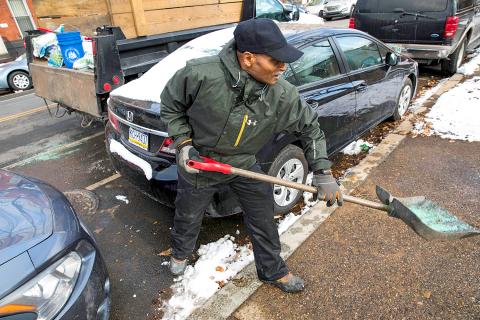A few years ago, Derek Hobbs could not find a job. He had three strikes against him: his age, 55, a criminal record, and a drug addiction that kept him out of the formal workforce for more than 25 years.
When he decided to turn his life around, most employers dismissed him without a thought. Determined to succeed, Hobbs turned to an innovative program specializing in matching people facing employment challenges, to available jobs.
“They actually give people with those strikes against them a chance,” he says.

Photo: AFP
Hobbs is just one example of a growing problem in the US economy: companies unable to find workers with the right skills to fill open positions, and workers who can’t find a job because they have the wrong skills.
The program Hobbs attended is in an impoverished area of Philadelphia, the neighborhood featured in the popular Will Smith sitcom from the 1990s, The Fresh Prince of Bel-Air: an area so dangerous his mother sent him to live with wealthy relations in California.
The West Philadelphia Skills Initiative (WPSI) is unique among employment training programs. It has a hyper-local focus, with workers coming only from the area known as University City, and it trains workers for jobs that already exist in the area.

Photo: AFP
This 6.2 square kilometer area houses two prestigious universities, research hospitals and numerous businesses. But 31 percent of residents live below the poverty line.
While Hobbs had a good work history as a young adult, “from the early 90s through 2012, I was an addict,” he says.
Like him, many West Philadelphia residents do not have a solid habit of work. A key challenge is to loosen the “glue” that holds them in place, surrounded as they are by friends and neighbors who don’t work, according to Sheila Ireland, who ran the WPSI program for many years.

Photo: AFP
WORKER SHORTAGE
With the US economy creating new jobs at a solid pace of close to 175,000 a month, and with unemployment at 4.1 percent, lower than it has been in 17 years, companies nationwide complain they cannot fill openings, even for jobs that do not require advanced skills.
The country has over six million unfilled jobs, the most since the government first began collecting data in December 2000, and yet many workers have given up looking and left the workforce, or are working part time because they cannot find a full-time position. The typical response when workers are hard to find is to raise wages and benefits, but wage growth has been stagnant or tepid at best, just slightly higher than inflation.
Economists disagree on the primary cause of this mismatch between skills and available jobs — and some say companies simply need to raise wages to attract older or discouraged workers back into the labor force. But new programs have sprung up to resolve the disconnect.
Traditional unemployment and retraining centers offer courses in things like computer skills, and then send workers out into the market in the hope they will find a job. But more programs like WPSI are being developed to give workers the exact skills employers need. Many partner with community colleges to tailor the training to specific fields where openings already exist, such as nursing and health care.
THE RIGHT MATCH
The lack of workers is a drag on the US economy that could get worse.
Economist David Wiczer of the St Louis Federal Reserve Bank said having workers poorly matched to jobs mean lost wages and lost growth that accelerates over time.
Poorly matched workers “are paid less, their pay grows less, and they are more likely to leave,” he says. These mismatches “tend to persist quite a long time,” and over 15 years they are getting paid US$120,000 less, which is US$120,000 they are not spending in the economy.
Companies historically used in-house training or apprenticeship programs to make sure they had workers specifically trained for their jobs. But labor unions traditionally ran those programs and American unions have been in decline for years, leaving workers to find their own training.
“We have to convince industry that there are strategies and methodologies that work, but there are costs,” says Ireland.
Unlike most programs where anyone can participate, WPSI takes an unusual “magnet school” approach to job training: anyone can apply but only a limited number are accepted for each cohort, or training class.
“It’s just a game changer when it comes to how we recruit,” said Al Santosusso, director of operations for Allied Universal, a security firm and long-time WPSI partner.
Graduates are not guaranteed jobs, but the hire rate has averaged 90 percent and last year was over 96 percent. And more importantly the retention rate in the new jobs is 25 percent higher than traditional training programs.
After decades on the sidelines, Hobbs now has a job for a local landscaping service, with benefits and a retirement savings plan. “Without God and WPSI, I wouldn’t be where I’m at.”

On April 26, The Lancet published a letter from two doctors at Taichung-based China Medical University Hospital (CMUH) warning that “Taiwan’s Health Care System is on the Brink of Collapse.” The authors said that “Years of policy inaction and mismanagement of resources have led to the National Health Insurance system operating under unsustainable conditions.” The pushback was immediate. Errors in the paper were quickly identified and publicized, to discredit the authors (the hospital apologized). CNA reported that CMUH said the letter described Taiwan in 2021 as having 62 nurses per 10,000 people, when the correct number was 78 nurses per 10,000

As we live longer, our risk of cognitive impairment is increasing. How can we delay the onset of symptoms? Do we have to give up every indulgence or can small changes make a difference? We asked neurologists for tips on how to keep our brains healthy for life. TAKE CARE OF YOUR HEALTH “All of the sensible things that apply to bodily health apply to brain health,” says Suzanne O’Sullivan, a consultant in neurology at the National Hospital for Neurology and Neurosurgery in London, and the author of The Age of Diagnosis. “When you’re 20, you can get away with absolute

May 5 to May 11 What started out as friction between Taiwanese students at Taichung First High School and a Japanese head cook escalated dramatically over the first two weeks of May 1927. It began on April 30 when the cook’s wife knew that lotus starch used in that night’s dinner had rat feces in it, but failed to inform staff until the meal was already prepared. The students believed that her silence was intentional, and filed a complaint. The school’s Japanese administrators sided with the cook’s family, dismissing the students as troublemakers and clamping down on their freedoms — with

As Donald Trump’s executive order in March led to the shuttering of Voice of America (VOA) — the global broadcaster whose roots date back to the fight against Nazi propaganda — he quickly attracted support from figures not used to aligning themselves with any US administration. Trump had ordered the US Agency for Global Media, the federal agency that funds VOA and other groups promoting independent journalism overseas, to be “eliminated to the maximum extent consistent with applicable law.” The decision suddenly halted programming in 49 languages to more than 425 million people. In Moscow, Margarita Simonyan, the hardline editor-in-chief of the